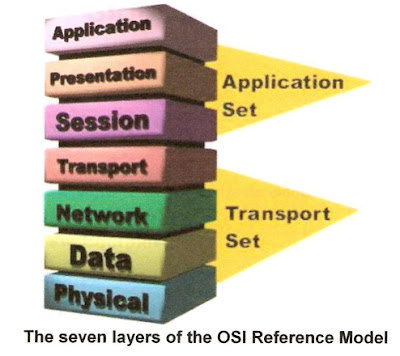|
Introduction Advantages Networking Goals Networking Criteria Applications Common Terminology Used In Internet Network Topologies Types of Network LOCAL AREA NETWORK LAN Transmission Methods LAN Topologies LAN Devices Networking Basics OSI REFERENCE MODEL |
The Layers:-
Think of the seven layers as the assembly line in the
computer. At each layer, certain things happen to the data prepare it for the
next layer. The seven layers, which separate into two sets, are:
Application
Set
Layer 7:
Application- This is the layer that actually interacts with the operating
system or application whenever the user chooses to transfer files, read
messages or perform other network-related activities.
Layer 6: Presentation- Layer 6 takes the data provided by the Application
layer and converts it into a standard format that the other layers can
understand.
Layer 5:
Session- Layer 5 establishes,
maintains and ends communication with the receiving device.
Transport
Set
Layer 4:
Transport- This layer maintains flow
control of data and provides for error checking and recovery of data between
the devices. Flow control means that the Transport layer looks to see if data
is coming from more than one application and integrates each application’s data
into a single stream for the physical network.
Layer 3:
Network- The way that the data will
be sent to the recipient device is determined in this layer. Logical protocols,
routing and addressing are handled here.
Layer 2:
Data- In this layer, the appropriate
physical protocol is assigned to the data. Also, the type of network and the
packet sequencing is defined.
Layer 1: Physical- This is level of the actual hardware. It defines the
physical characteristics of the network such as connections, voltage levels and
timing.
|
|---|
OSI REFERENCE MODEL
Subscribe to:
Post Comments (Atom)

No comments:
Post a Comment